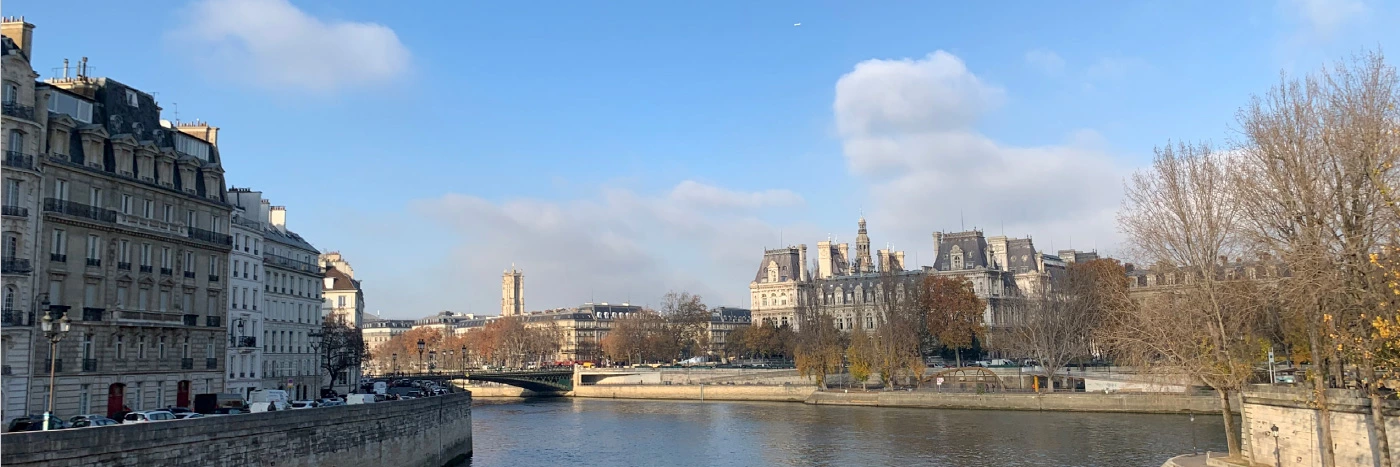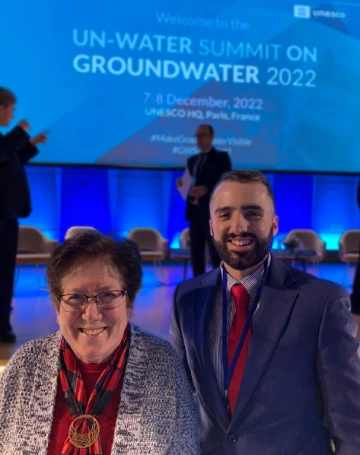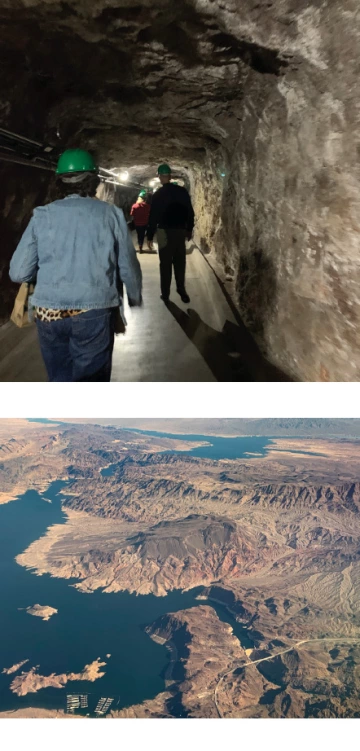
Seine River, Paris. Photo: Sharon B. Megdal
As reflected in past essays, I consider it useful to think about our serious water challenges as wicked problems. Wicked problems are complex, and addressing them can be complicated by factors such as poverty, climate change, and geopolitics. There is rarely a single solution to a wicked water problem; rather, pathways to solutions must be considered. Discussing our myriad water challenges in the context of wicked problems helps temper expectations that there will be quick fixes and explain that it will take much cooperation, study, and innovation, as well as resources (time and money), to tackle them. The complexities associated with finding solutions to wicked water problems were underscored at two December 2022 conferences I attended. The first, the United Nations (UN) Groundwater Summit, held in Paris, focused on groundwater-related aspects of achieving Goal 6 of the UN Sustainable Development Goals (SDG6): ensuring availability and sustainable management of water and sanitation for all. The second conference, held at Caesar’s Palace in Las Vegas, was the annual meeting of the Colorado River Water Users Association (CRWUA), where the implications of low Colorado River flows and storage were discussed.
Key take-aways from both conferences were similar; we must consider all water sources, include climate change with our multiple supply issues, and account for different geographic levels in our search for pathways to solutions. For me, however, a major difference between the conferences was in the feelings they inspired. Let me briefly write about each.
The UN Groundwater Summit, held December 6-8, 2022, consisted of three full days of sessions. The key focus was on how groundwater will contribute to achieving SDG6. Knowing that many readers do not follow SDG issues closely, I provide the sub-targets for SDG6, most of which have 2030 as the achievement date:
- Achieve universal and equitable access to safe and affordable drinking water for all;
- Achieve access to adequate and equitable sanitation and hygiene for all and end open defecation, paying special attention to the needs of women and girls and those in vulnerable situations;
- Improve water quality by reducing pollution, eliminating dumping and minimizing release of hazardous chemicals and materials, halving the proportion of untreated wastewater and substantially increasing recycling and safe reuse globally;
- Substantially increase water-use efficiency across all sectors and ensure sustainable withdrawals and supply of freshwater to address water scarcity and substantially reduce the number of people suffering from water scarcity;
- Implement integrated water resources management at all levels, including through transboundary cooperation as appropriate; and
- By 2020, protect and restore water-related ecosystems, including mountains, forests, wetlands, rivers, aquifers and lakes [and support capacity building in developing countries and local communities by 2030].

Youth Forum member and UArizona graduate student
Joseph Fickett and WRRC Director Sharon B. Megdal
participate in Transboundary Aquifers session.
These are indeed worthy goals, for which indicators have been developed to monitor progress. The progress toward some goals, such as water use efficiency, is difficult to quantify. After a day that included three tracks of pre-sessions on topics relevant to groundwater and SDG6, the first day of plenary session focused on five foundational elements for achieving the targets: (1) data and information, (2) capacity development, (3) innovation, (4) finance, and (5) governance. These are universal elements to addressing wicked water problems. The final day focused on regional challenges and solutions, including those of Africa and transboundary aquifers, reminding us to consider geographic scale in generating solutions. This last day also had a session devoted to strengthening the science-policy-practice interface and another focused on a recently formed global Groundwater Youth Forum. Youth Forum member and UArizona graduate student Joseph Fickett and I served as reporters for the session on transboundary aquifers. (Joseph graduated a week after the conference with an MS degree in Water, Society, and Policy.) There was commonality in the messaging by governmental representatives and other experts in their presentations and commentary. Messages related to quantifying and/or characterizing the challenges, identifying the players who must be involved in identifying and implementing solutions, and removing obstacles to forging the pathways toward achieving the goals. An overall summary of the conference is expected to be released before the March 2023 UN Water Conference. A key objective of the UN Groundwater Summit was to develop strong messaging on the role of groundwater quantity and quality in meeting global water needs. The March conference, which will be held at the UN in New York City, will be only the second UN Water Conference to be convened. The first was held in 1977 in Argentina.
This year’s well-attended CRWUA annual conference had the theme, “The Colorado River Compact – 100 years & beyond.” I expect most there would have appreciated a more celebratory mood at the Colorado River Compact centennial, but river conditions did not allow for celebration. The first-day colloquia were on “Messaging in a More Water-Challenged World” and “Adapting to the New Normal: Trying Technology and Tools.” The morning sessions on the first full day included varied perspectives from the Colorado River Basin, and the afternoon’s concurrent sessions focused on funding, trade-offs and turbulence, collaborative options, and how companies are adapting to a drier future; clearly not cheerful topics. The final morning of the conference featured the messages of federal officials from Mexico and the US. No one could avoid talking about the seriously challenging river conditions. It was impossible to overstate how much work is required to address the current threats to water supply and power generation. There is no time to lose. At the conference, an end-of-January deadline was established by Bureau of Reclamation Commissioner Camille Calimlim Touton for the seven basin states (Arizona, California, Colorado, New Mexico, Nevada, Utah, and Wyoming) to come up with a plan to reduce water deliveries by millions of acre feet—substantially greater reductions than the Tier 2a deliveries that became effective January 1, 2023. If no plan is presented, unilateral federal action was promised. Though when a prior deadline was missed in August 2022, the Department of Interior did not announce unilateral action, it is clear that action must be taken in 2023 to have a chance at maintaining reliable water and hydropower deliveries. Whether the parties to state-level deliberations can come to agreement to feed into a basin-level agreement in the short time available remains to be seen. Though a series of storms is hammering the West as I write this, the reader must remember two truths: (1) one good winter will not provide relief from years of low Colorado River flows and reduced storage; and (2) in past years, run-

Top: Inside Hoover Dam. Photo: Sharon B. Megdal
Bottom: Lake Mead and Hoover Dam. Photo: Sharon B. Megdal
off from precipitation has been much lower than expected due to high springtime temperatures and dry soil conditions. (See Jim Prairie’s excellent CRWUA presentation, which can be found starting at about two minutes into the session video, with the slides available here.) Reclamation’s ongoing formal consultations on changing dam operations and redoing the shortage sharing regulations continue, as do related consultations with Native Nations. The variety and intensity of necessary efforts are daunting. Reclamation Deputy Commissioner of Operations David Palumbo made a point about policy I heard mentioned in later hallway conversations. Palumbo noted that, as with the concept of hydrologic non-stationarity (made famous by the 2008 Milly et al. paper, “Stationarity Is Dead: Whither Water Management?”), policy can no longer be considered stationary. New policies are necessary to address an unprecedented situation.
Though the sessions were informative and stimulating, I am glad I was able to take an organized side tour at each conference. A visit to the Paris Sewer Museum, which explains the system of collecting Paris’ wastewater, reminded me that good engineering can endure for years. Similarly, a visit to Hoover Dam provided evidence of the amazing engineering that resulted in construction of the colossal dam, which became operational over 85 years ago. However, while Paris’ wastewater flows abundantly, low water levels at Hoover Dam’s intake towers starkly remind us of the implications for water deliveries and power generation.
The sense of serious purpose in facing the critical issues at both conferences was palpable. Though people seemed to understand that the SDG6 target and sub-targets will not be fully achieved, they also expressed an understanding that tenacity and hard work can result in significant progress toward relief from the dire individual and community consequences that come with lack of access to water and sanitation. The sentiment at CRWUA was urgency; the hard work of reducing water deliveries to avoid an impending large-scale calamity is needed now. Of course, there will be burdens associated with reducing water deliveries, but there is no choice. Yet, along with the somber messaging at CRWUA, we should remember that we have options. Some have access to other water sources, and efforts are underway to augment supplies. In addition, there are opportunities on the demand side of the equation to adapt by reducing water consumption.
Over the years, in many of my lectures, I have pointed to the half-full glass of water and noted that the portion of the glass I focus on depends on whether my mood is optimistic or pessimistic. When addressing wicked water problems, I prefer to focus on the half-full portion, though the Colorado River storage system, admittedly, is now only about one-quarter full. My reasoning is that we will need optimism, globally and regionally, to get us through the difficulties associated with finding pathways to solutions for our wicked water problems.

